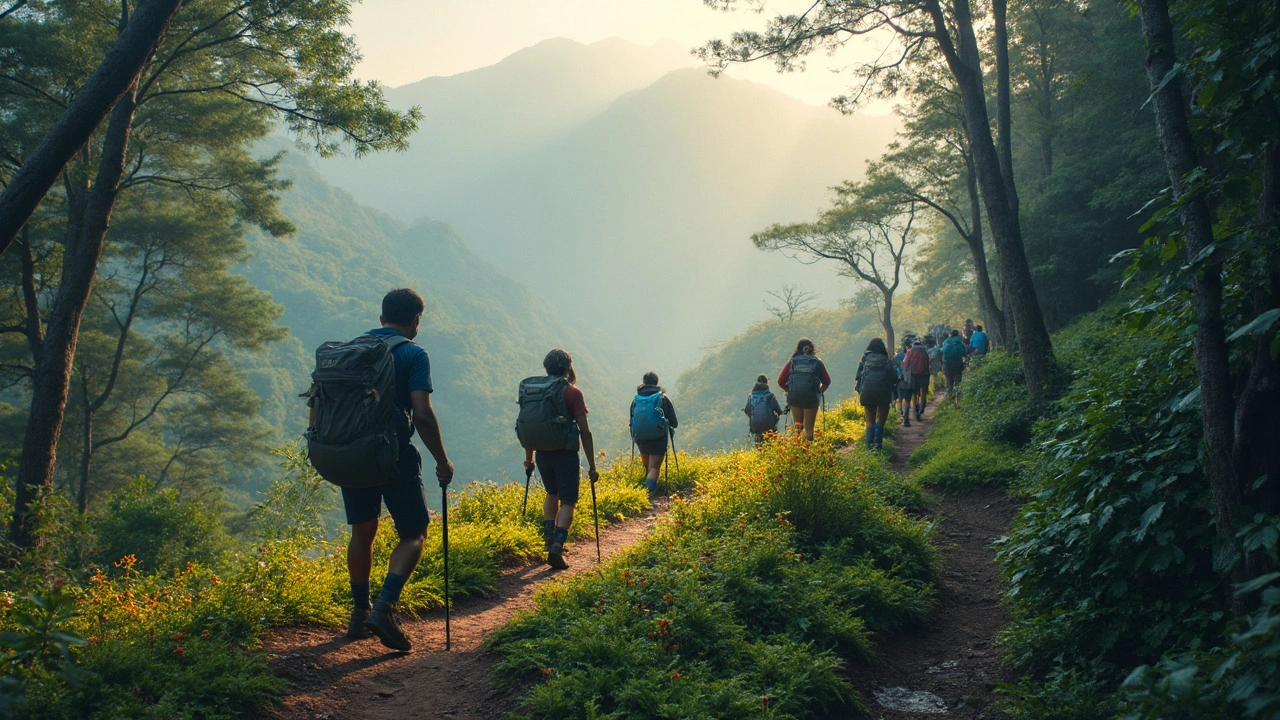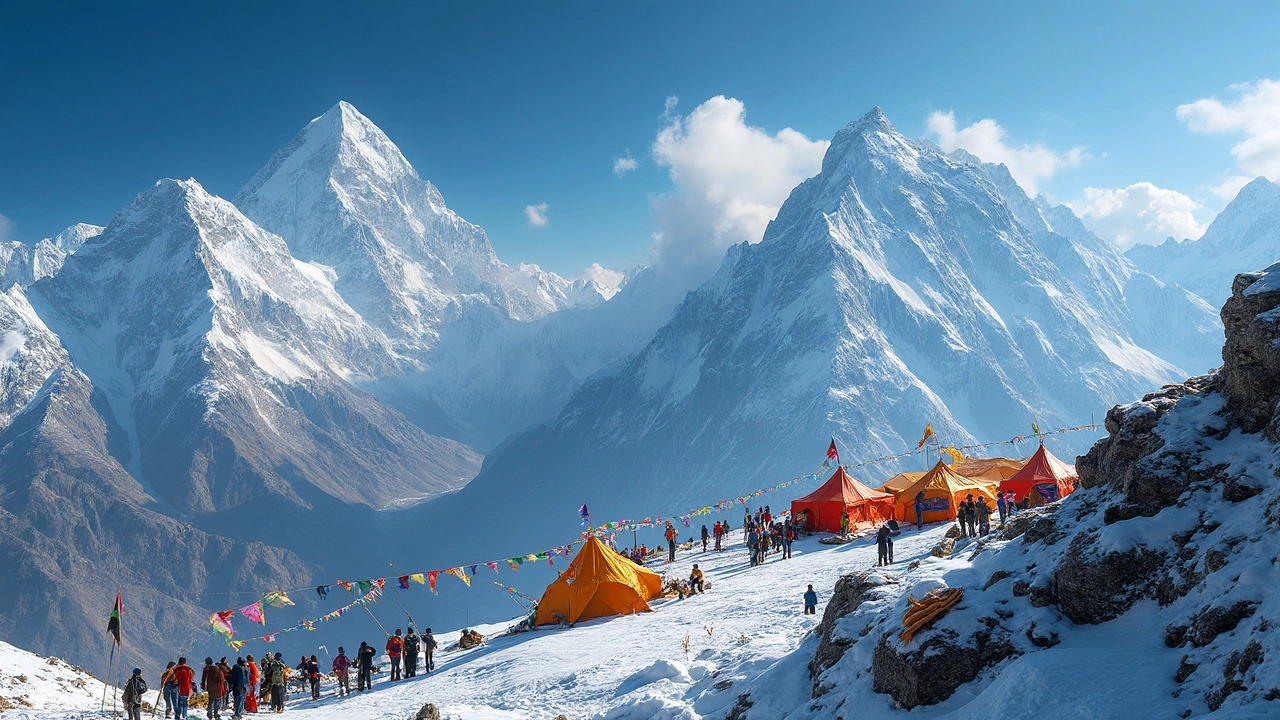Best Country for Trekking: India's Top Trails and Why They Stand Out
 Jun, 21 2025
Jun, 21 2025
Ask a hardcore trekker where to find the world’s longest, wildest, and most jaw-dropping trails—and India always comes up. From the snow-piled peaks of the Himalayas to the lush Western Ghats, you get a mash-up of terrains you won’t find anywhere else.
Maybe you’re chasing Instagram gold like the frozen Zanskar river, or maybe you want something quieter like the tropical forests of Kerala. India’s trails suit every mood. The cool bit? You can go solo, book a group, or even join local guides who know the shortcuts where you’ll spot wild goats and mud-caked monks.
Prices here can be ridiculously low—think shoestring backpacker budgets—but you still get big-league trekking experiences. Everything’s easy to access if you know when and where to look. And it’s wild how some treks, like Chadar or Rupin Pass, completely change with the season. One trail, endless vibes.
- What Makes India a Trekker’s Dream
- Top Trekking Regions and Must-Do Trails
- Tips for Trekking India Like a Pro
- Hidden Facts and Local Insights
What Makes India a Trekker’s Dream
India packs in more trekking variety than pretty much anywhere else. You don’t just get mountains—you get Himalayan giants, rolling green Western Ghats, the wild jungles of the Northeast, and even desert trails in places like Ladakh and Rajasthan. If you’re a fan of changing scenery, this country delivers hard.
Let’s talk stats. The Himalayas alone stretch across five Indian states, covering over 2,500 kilometers. That means a trek like the Great Himalayan Trail stretches for about 4,500 kilometers—way longer than the famous Appalachian Trail. You can start with gentle weekend hikes or sign up for altitude-packed expeditions like Stok Kangri or Kanchenjunga Base Camp.
India is also perfect if you’re budget conscious. Compared to popular trekking countries like Nepal or Switzerland, permits, guides, food, and transport cost way less. Here’s a quick look at average trekking costs in India versus other top spots:
| Country | Avg Cost Per Day (USD) |
|---|---|
| Trekking in India | 25 - 70 |
| Nepal | 35 - 100 |
| Switzerland | 90 - 250 |
Cultural variety is another thing you won’t get everywhere. One trek takes you through Buddhist monasteries and ancient villages, the next into coffee-scented mountain towns. Festivals happen everywhere, and you’ll often stumble on local feasts, hillside temples, or groups of mountain kids playing cricket out of nowhere.
If safety worries you, remember that India’s trekking circuit is busy, even in offbeat places. Rescue services, local guides, and plenty of established trails make it a solid choice for both new and experienced trekkers. English is widely spoken in trekking hubs, so you never feel completely lost.
Bottom line? Whether you want mild adventure or a serious high-altitude challenge, this country’s got you. For the biggest bang for your buck, you won’t beat India’s mix of landscapes, accessible trails, and authentic culture—all packed into one place.
Top Trekking Regions and Must-Do Trails
When it comes to trekking in India, the country’s wild variety will blow your mind—every region gives you something different. The Himalayas steal the show, but don’t sleep on the south and northeast. Here’s what stands out:
- Himachal Pradesh: This is ground zero for classic Himalayan treks. You’ve got Hampta Pass (perfect for beginners stepping up), the always-popular Triund with its epic sunrise, and Pin Parvati Pass for those who want a tough challenge. Each trek gives you a crazy switch-up in scenery, from pine forests to snow deserts.
- Uttarakhand: If you want variety, this region’s it. Kedarkantha trek is popular for winter newbies; Roopkund’s “Skeleton Lake” is pure legend—imagine climbing up to a high-altitude mystery. Valley of Flowers is all about monsoon beauty, with thousands of blooming plants from July to September.
- Ladakh: If aliens landed and asked, “Show us something unique,” you’d bring them here. The Chadar Trek on the frozen Zanskar River is nuts—only doable in dead winter. Markha Valley gives you classic moonscapes, tiny Buddhist villages, and high passes at 5,200 meters.
- Sikkim: Picture a trek with full-on Everest and Kanchenjunga views, minus big crowds. Goecha La trek is the one. Plus, the Dzongri trek packs a punch for those wanting high-altitude without losing a week.
- Western Ghats: Far from all the snow hype, this southern region offers rainforests, ancient forts, and waterfalls. Kumara Parvatha and Tadiandamol in Karnataka are top picks after the monsoon, while Maharashtra’s Sahyadris light up during the rains (July to September).
Want some quick stats? Here’s how a few of India’s most famous treks stack up:
| Trek | Region | Distance (km) | Best Season | Difficulty |
|---|---|---|---|---|
| Chadar | Ladakh | 62 | Jan-Feb | Hard |
| Hampta Pass | Himachal | 26 | June-Sept | Moderate |
| Valley of Flowers | Uttarakhand | 38 | July-Sept | Easy-Moderate |
| Goecha La | Sikkim | 90 | Apr-May, Oct-Nov | Moderate-Hard |
| Kumara Parvatha | Karnataka | 22 | Oct-Feb | Hard |
If you can, try out more than one region. Each has its vibe, weather, local eats, and challenges. One thing’s for sure—wherever you trek in India, you’ll end up with a story worth telling.

Tips for Trekking India Like a Pro
You don’t want surprises in the wild, so here’s how to actually enjoy trekking in India like you know what you’re doing. Forget vague tips—let’s get real about what works out here.
- Pick the Right Season: Mountain weather is a wild card. Most treks in the Himalayas open up from May to October. For the Western Ghats, avoid monsoon (June to September), unless you love leeches and landslides.
- Acclimatize Properly: High-altitude zones like Ladakh or Himachal can smack you with headaches and nausea if you rush. Plan at least 1–2 days at the base. Hydrate way more than you think you need.
- Packing Smart: Local shops can save you if you forget something, but don’t count on finding fancy gear in remote villages. Pack light, but never skip layers, rain protection, or blister kits.
- Go Local for Guides: Trained local guides know shortcuts, safe river crossings, and the best food stops. Plus, more of your money stays in mountain towns instead of big companies.
- Stay Connected (But Don’t Rely on It): Out here, you’ll lose mobile data. Download offline maps, or just go old school with a printed map if network breaks are a deal-breaker.
Ever get confused by what weather or road closures look like month to month? Here’s a cheat sheet for popular trekking months and regions:
| Region | Best Season | Expected Weather | Network Access |
|---|---|---|---|
| Himachal Pradesh | May–October | Cool days, chilly nights | Patchy; best in towns |
| Uttarakhand (Valley of Flowers, Roopkund) | June–September | Wet spells, stunning blooms | Mostly spotty on trails |
| Ladakh (Chadar, Markha Valley) | July–September for most; January–February for Chadar | Biting cold to freezing | Barely there, maybe Leh |
| Western Ghats (Karnataka, Kerala) | October–March | Mild, some rain | Decent, but drops in forests |
Bring cash—remote tea stalls and homestays rarely take cards. If you have dietary needs, carry snacks; tiny villages eat what’s local, often just rice and dal. And listen, trekking permits for famous routes (like Roopkund or Valley of Flowers) can change year to year, so double-check just before you travel.
Last thing—don’t leave trash behind, and don’t trust everything you read online about how “easy” a trek is. Ask locals or check the latest updates from fellow hikers. That’s how you keep yourself—and India’s trails—in top shape.
Hidden Facts and Local Insights
There’s stuff about trekking in India you won’t read in fancy brochures. Like, did you know that some of the highest villages on earth—Hikkim, Komic, and Langza—sit right along popular trails in Himachal? If you want real mountain life, skip the hotel and ask a villager for a homestay. You’ll get yak butter tea and stories you can’t Google.
Most trekkers hit Manali and Leh, but try the Dzongri trek in Sikkim if you want crazy rhododendron forests and a shot at seeing the sunrise on Kangchenjunga. And in the Western Ghats, you’ll find the ancient Chowdeshwari temple tucked behind Kudremukh’s green hills—the locals say you haven't truly trekked here until you spot it.
Traveling solo? Look for local hiking clubs in places like Dehradun or Bengaluru. Some of them even organize monthly treks under the full moon—zero Instagram filters needed, because the views are bonkers. Another unspoken rule: wherever you trek, chai shops just pop up on impossible slopes. Always carry some loose change for tea and pakoras. They’re lifesavers in the cold.
If you go during monsoon, some trails in the Western Ghats close to protect rare frogs and snakes. Respect the forest rules, and you’ll be let in on secrets most tourists miss. Need to plan your trip? Here’s a handy rundown of India’s main trekking regions, the best months to visit, and some must-try local snacks you’ll find on the way:
| Region | Best Time | Top Snack |
|---|---|---|
| Himalayas (Uttarakhand, Himachal, Ladakh) | May-June & Sept-Oct | Thukpa (noodle soup) |
| Sikkim & Northeast | March-May & Sept-Nov | Momos (dumplings) |
| Western Ghats (Karnataka, Maharashtra, Kerala) | Oct-Feb | Banana chips |
If you want trekking in India to feel epic, mingle with the porters and guides. Most speak a bit of English and they know every shortcut, campfire story, and spot for mountain selfies. And here’s a hack: ask your guide to show you the closest village festival. Sometimes your best adventure isn’t on the map at all.